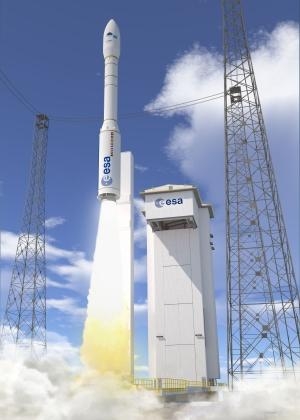Fri, Jan 20, 2012
ESA's Completes Final Checks On New Launcher
Final checkout of Europe’s new Vega launcher was
completed a week ago Friday, marking another milestone towards
its maiden flight from Europe’s Spaceport in Kourou, French
Guiana. The first Vega launch campaign began in November with the
installation of the P80 first stage on the launch pad. The two
solid-propellant second and third stages were added to the vehicle,
followed by the AVUM – Attitude & Vernier Upper Module
– liquid-propellant fourth stage. All four stages have
undergone final acceptance, including the testing of the avionics,
guidance, telemetry, propulsion, separation pyrotechnics and safety
systems.

These steps culminated on 13 January with Vega’s
‘synthesis control checks’, where all systems were put
into launch mode for the vehicle’s final acceptance. This
included pressurising the AVUM propulsion systems that actuate the
thruster valves. The rocket’s elements were switched on from
the control bench to simulate the launch countdown. The onboard
software then took over and simulated the different stages of a
flight. The interfaces between the vehicle and the control bench
were also tested. The test review confirmed that everything ran as
expected and that the launcher is ready for flight.
In the next phase of launch preparations, the ‘upper
composite’ – the fairing and payload – will be
integrated, followed by final checkout of the fully assembled
launcher and the countdown rehearsal. The first launch, VV01, is
targeted for 9 February. It will carry nine satellites into orbit:
the Italian space agency’s LARES and ALMASat-1, together with
seven CubeSats from European universities. This mission aims to
qualify the Vega launch system, including the vehicle, its launch
infrastructure and operations, from the launch campaign to payload
separation and disposal of the upper module.
Vega is designed to cope with a wide range of missions and
payload configurations in order to respond to different market
opportunities and provide great flexibility. In particular, it
offers configurations able to handle payloads ranging from a single
satellite up to one main satellite plus six microsatellites. Vega
is compatible with payload masses ranging from 300 kg to 2500 kg,
depending on the type and altitude of the orbit required by the
customers. The benchmark is for 1500 kg into a 700 km-altitude
polar orbit. (Image provided by ESA)
More News
Aero Linx: Model Aeronautical Association of Australia MAAA clubs are about fun flying, camaraderie and community. For over 75 years, the MAAA has been Australia’s largest fl>[...]
Touchdown Zone Lighting Two rows of transverse light bars located symmetrically about the runway centerline normally at 100 foot intervals. The basic system extends 3,000 feet alon>[...]
“Discovery and innovation are central to our mission at Virgin Galactic. We’re excited to build on our successful record of facilitating scientific experiments in subor>[...]
How To Get A Story On Aero-TV News/Feature Programming How do I submit a story idea or lead to Aero-TV? If you would like to submit a story idea or lead, please contact Jim Campbel>[...]
Student Pilot Reported That During Rotation, “All Of A Sudden The Back Of The Plane Kicked To The Right..." Analysis: The student pilot reported that during rotation, “>[...]
 ANN's Daily Aero-Linx (05.02.24)
ANN's Daily Aero-Linx (05.02.24) ANN's Daily Aero-Term (05.02.24): Touchdown Zone Lighting
ANN's Daily Aero-Term (05.02.24): Touchdown Zone Lighting Aero-News: Quote of the Day (05.02.24)
Aero-News: Quote of the Day (05.02.24) ANN FAQ: Contributing To Aero-TV
ANN FAQ: Contributing To Aero-TV NTSB Final Report: Cirrus Design Corp SR20
NTSB Final Report: Cirrus Design Corp SR20



